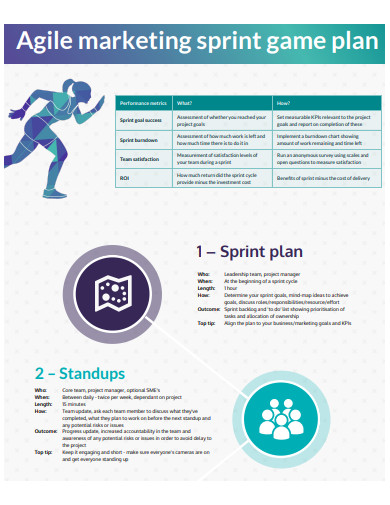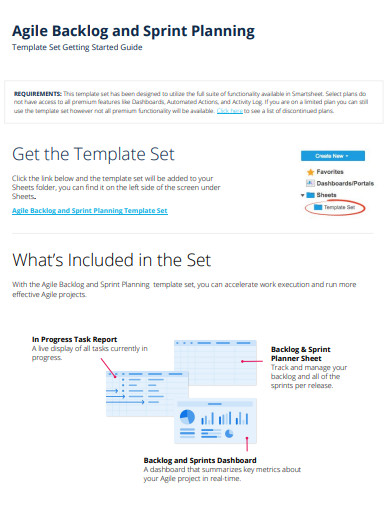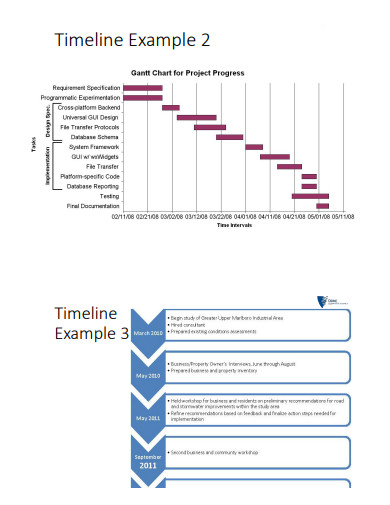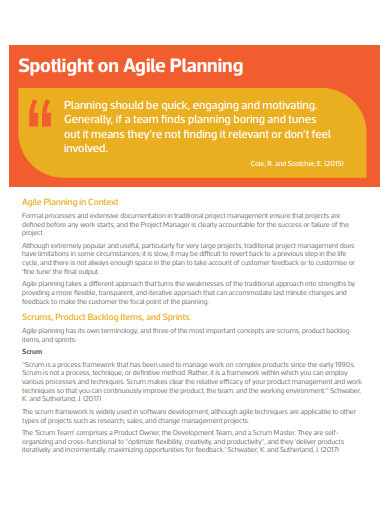In the Scrum methodology, sprint planning is when the team decides which sprint backlog they will focus on throughout that sprint and outlines their initial plan for finishing those product backlog items. Establishing a sprint goal and using that as the foundation for determining which product backlog items to concentrate on during that sprint may be beneficial to teams. Agile approaches require sprint planning to be successful. Team members may struggle to comprehend what they each ought to concentrate on if product managers or Scrum masters don’t take the time to plan out prospective work—especially if there are any connections between recent and future activities.
3+ Agile Sprint Plan Samples
Sprint planning is a phase in Agile techniques when teams identify which tasks to perform in the next sprint and how they will accomplish them. A sprint planning meeting is one that is solely focused on the next sprint. This meeting is generally led by the product owner or a Scrum master, depends on the methodology utilized.
Product managers or Scrum masters select particular product backlog items that fulfill their sprint objectives during the sprint planning meeting. These choices are taken in consultation with the Scrum team so that everyone is aware of what work will be done in the future sprint. The team’s developers can assist in identifying specific talents in which they excel and determining their bandwidth for the upcoming sprint.
1. Agile Marketing Sprint Game Plan
2. Agile Backlog and Sprint Planning
3. Agile Project Management Sprint Planning
4. Sample Agile Sprint Plan
A new sprint’s management is never a precise science, and it requires a mutual understanding among team members to succeed. After a sprint review, which is a length of transition during which team members deliberate on the previous sprint, sprint planning takes place. This typically occurs at the conclusion of a sprint.
When you and your team are deciding which sprint backlog items to execute next, there are three factors to keep in mind.
What: This is the sprint target or goal you intend to attain. The items you choose from the program backlog should all be related to the sprint’s goal. The sprint goal is almost always linked to a larger goal, such as an OKR.
How: This refers to the effort required to finish a backlog item, as well as the precise tactics that your team will employ. Team members collaborate with Scrum masters and product managers to determine if sprint backlog items must be completed in a specified order. All of this is covered in sprint planning. When the sprint is running, everyone on the Scrum team will actually know what they should do.
Who: This is the team of persons tasked with accomplishing various backlog items. The “who” is an important part of sprint planning meetings because it avoids work overlap and guarantees that the work in the sprint backlog does not surpass your team’s capabilities. It also gives important stakeholders a visible point of contact for each object in the sprint backlog by emphasizing who is accountable for each job.
The team room is a wonderful place to organize sprints because it lets you connect to all of the data about your product backlog and allows you to review and change any informational radiators you need.
If your team is dispersed, sprint planning is a great way to bring everyone together so that your planning talks are more productive and the team’s individual relationships are strengthened.
FAQs
Why is this sprint valuable?
In this Sprint, the Product Owner proposes ways to improve the product’s value and utility. After that, the entire Scrum Team works together to develop a Sprint Goal that explains why the Sprint is important to stakeholders. Prior to the end of Sprint Planning, the Sprint Goal must be finalized.
What can be done with this sprint?
The Developers choose things from the Product Backlog to include in the current Sprint after consulting with the Product Owner. During this process, the Scrum Team may modify these items, increasing understanding and trust. Choosing how much can be accomplished in a Sprint can be difficult. The more information the Developers have about their previous performance, future capability, and Definition of Done, the more confident they will be in their Sprint projections.
How will the chosen work get done?
The Developers plan the work required to build an Increment that meets the Definition of Done for each Product Backlog item specified. This is frequently accomplished by breaking down Product Backlog items into one-day or shorter work items. The Developers have complete control over how this is accomplished. No one else can advise them how to convert Product Backlog items into value increments. The Sprint Backlog is made up of the Sprint Goal, the Product Backlog items chosen for the Sprint, and the plan for delivering them. Sprint planning is limited to an eight-hour maximum for a one-month Sprint. The event is usually shorter for shorter Sprints.
Sprint planning is commonly utilized when your team follows the Sprint framework or has a methodology that involves timed iterations. Even if you use a flow-based methodology, an event comparable to sprint planning can help you create a mutual understanding of the items that need to be worked on next.
Related Posts
FREE 7+ Fashion Business Plan Samples in PDF
FREE 10+ Sprint Planning Samples In MS Word | Google Docs | PDF
FREE 10+ Wedding Planning Samples in MS Word | Apple Pages | Powerpoint | PDF
FREE 9+ Monthly Study Planner Samples in PSD | Illustrator | InDesign | PDF
FREE 9+ Sample Curriculum Planning Templates in PDF | MS Word
FREE 10+ Teacher Development Plan Samples in MS Word | Google Docs | Apple Pages | PDF
FREE 10+ Basketball Practice Plan Samples in PDF
FREE 12+ School Business Plan Samples in PDF | MS Word | Apple Pages | Google Docs
FREE 7+ Client Strategic Plan Samples in PDF | MS Word
FREE 11+ Trucking Business Plan Templates in PDF | MS Word | Google Docs | Pages
FREE 7+ Small Hotel Business Plan Samples PDF | MS Word | Apple Pages | Google Docs
FREE 14+ Bakery Business Plans in MS Word | PDF | Google Docs | Pages
FREE 4+ Yearly Lesson Plan Samples in PDF
FREE 50+ Strategic Planning Samples in Google Docs | Pages | PDF | MS Word
FREE 10+ Construction Project Plan Samples in MS Word | Google Docs | Apple Pages | PDF




